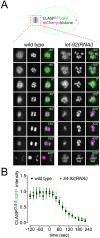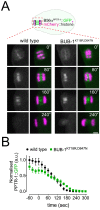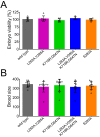BUB-1 targets PP2A:B56 to regulate chromosome congression during meiosis I in C. elegans oocytes
- PMID: 33355089
- PMCID: PMC7787666
- DOI: 10.7554/eLife.65307
BUB-1 targets PP2A:B56 to regulate chromosome congression during meiosis I in C. elegans oocytes
Abstract
Protein Phosphatase 2A (PP2A) is a heterotrimer composed of scaffolding (A), catalytic (C), and regulatory (B) subunits. PP2A complexes with B56 subunits are targeted by Shugoshin and BUBR1 to protect centromeric cohesion and stabilise kinetochore-microtubule attachments in yeast and mouse meiosis. In Caenorhabditis elegans, the closest BUBR1 orthologue lacks the B56-interaction domain and Shugoshin is not required for meiotic segregation. Therefore, the role of PP2A in C. elegans female meiosis is unknown. We report that PP2A is essential for meiotic spindle assembly and chromosome dynamics during C. elegans female meiosis. BUB-1 is the main chromosome-targeting factor for B56 subunits during prometaphase I. BUB-1 recruits PP2A:B56 to the chromosomes via a newly identified LxxIxE motif in a phosphorylation-dependent manner, and this recruitment is important for proper chromosome congression. Our results highlight a novel mechanism for B56 recruitment, essential for recruiting a pool of PP2A involved in chromosome congression during meiosis I.
Keywords: B56; Bub1; C. elegans; PP2A; SLiM; cell biology; meiosis.
© 2020, Bel Borja et al.
Conflict of interest statement
LB, FS, ST, CF, JB, PL, CS, JB, DC, FP No competing interests declared
Figures






















References
-
- Allan C, Burel JM, Moore J, Blackburn C, Linkert M, Loynton S, Macdonald D, Moore WJ, Neves C, Patterson A, Porter M, Tarkowska A, Loranger B, Avondo J, Lagerstedt I, Lianas L, Leo S, Hands K, Hay RT, Patwardhan A, Best C, Kleywegt GJ, Zanetti G, Swedlow JR. OMERO: flexible, model-driven data management for experimental biology. Nature Methods. 2012;9:245–253. doi: 10.1038/nmeth.1896. - DOI - PMC - PubMed
-
- Connolly AA, Osterberg V, Christensen S, Price M, Lu C, Chicas-Cruz K, Lockery S, Mains PE, Bowerman B. Caenorhabditis elegans oocyte meiotic spindle pole assembly requires microtubule severing and the calponin homology domain protein ASPM-1. Molecular Biology of the Cell. 2014;25:1298–1311. doi: 10.1091/mbc.e13-11-0687. - DOI - PMC - PubMed

